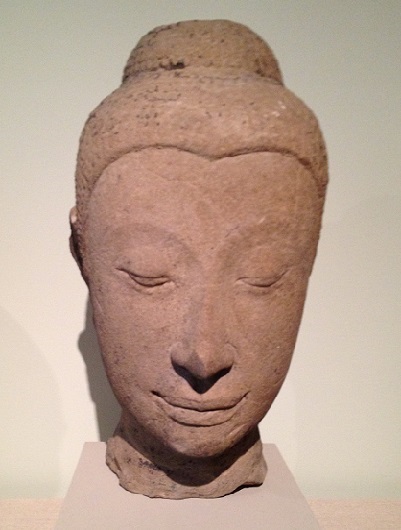
Unknown
Thai
Head of Buddha, 16th c. CE
stone with traces of pigment
15 1/4 × 8 1/4 × 8 1/4 in.
SBMA, Gift of Mrs. Otto Jeidels
1948.1.1
COMMENTS
PERIOD
Stone was an uncommon medium for sculpture during the period of Thai domination in Siam. Lopburi, a provincial center and summer residence of the Thai kings by the early 15th century, had a long history of stone work. The School of Lopburi lasted for a thousand years; stone statues were still created until the end of the 17th century. We may assume the head in our museum comes from that region. Lopburi had been the center of Khmer sovereignty in Siam for several hundred years, and stone was the favored material of the Khmer artisans. Ruins of Khmer temples still exist in this area.
The city of Ayudhya controlled most of Siam by the beginning of the 15th century and soon became the capital. In the middle of the same century it had set up dominion over most of modern Siam. By this time the Thai had lost the Khmer influence in their art style. Their Buddhist religion was a branch of the Hinayana Buddhism centering in Ceylon.
CONTENT
The head of the Buddha shows the Thai style of facial features--oval face, arched eyebrows, thin long nose with a sharp ridge, half-closed eyes turning upwards. The hair has a pattern of knobs for curls. The head is crowned by a simple ushnisha.
STYLE
The transition period from Khmer to Thai style may have lasted to the 15th century. Our sculpture seems to represent the final culmination of Thai art, developing from its pre-Thai style (the Mon), the early Thai style, and the Khmer influence. Thai art represents an abstract ideal. It soon became conventional, and its period lasted briefly. Decadence set in by the early 17th century.
MEDIA
Thai stone images are comparatively rare because Thai sculptors modeled mostly in bronze. Tin and copper were materials plentiful in southern Siam. Evidently stone was plentiful in the area of Lopburi because its school of stone sculpture was important for many centuries.
- from the Santa Barbara Museum of Art Docent Council files
